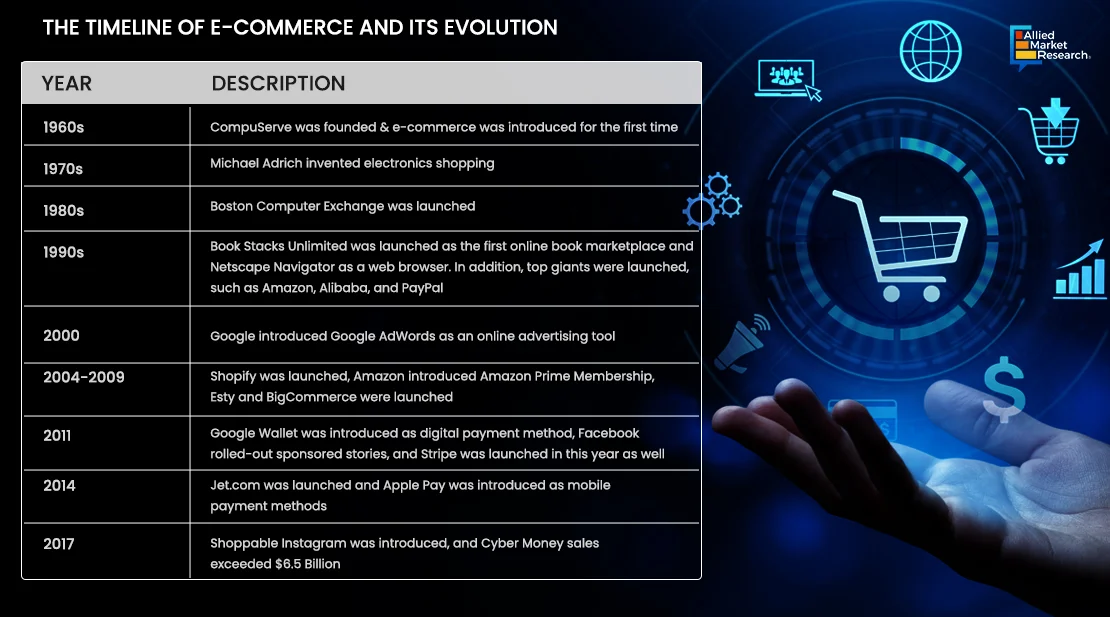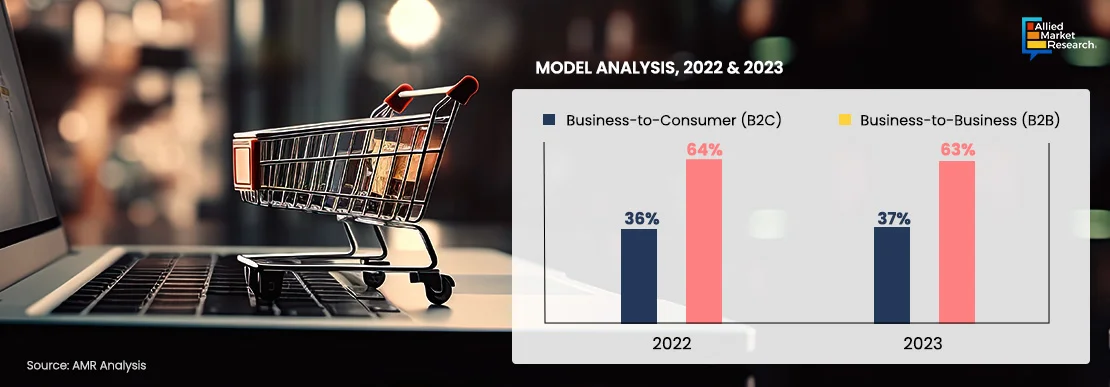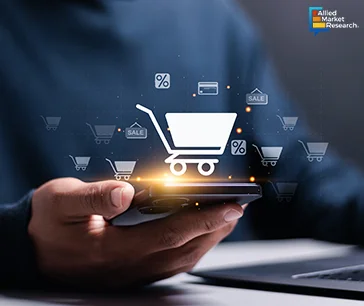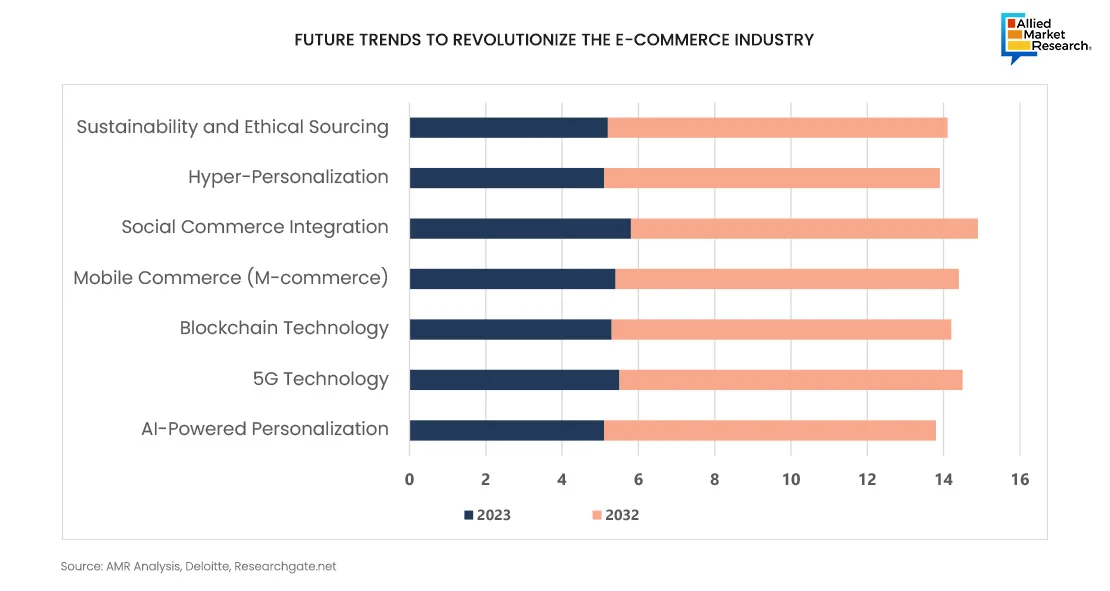E-commerce: The Future of Online Shopping

E-commerce was introduced in the 1960s, when companies started using an electronic system called the electronic data interchange (EDI) to enable the transfer of documents. It involves buying and selling goods or services on the Internet. It depends on technologies such as Internet marketing, mobile commerce, inventory management systems, electronic funds transfer, electronic data interchange (EDI), supply chain management, automated data collection systems, and online transaction processing. Over the years, e-commerce has evolved with the help of technological advancements and shift in consumer preferences. The COVID-19 pandemic further accelerated the shift toward e-commerce, with buyers altering their habits and businesses embracing digital strategies. Companies such as Amazon, Flipkart, Myntra, eBay, and Snapdeal have emerged as top e-commerce platforms among purchasers.
E-commerce has significantly impacted traditional retail by offering convenience, competitive pricing, and a seamless shopping experience. In addition, it has empowered businesses of all sizes to reach a global audience. E-commerce has led to the emergence of new business models, including drop-shipping and subscription services, and has facilitated the growth of digital payment systems.
Impact of E-commerce Companies
Technology is the backbone of the e-commerce industry. It bridges the gap between sellers and customers with the aid of these online platforms. The e-commerce system facilitates the effective management of customer orders, deliveries, returns, and payments of purchased goods. In addition, assisting in the development of e-commerce value chains in marketing, recruitment, and advertising enhances overall operational efficiency and promotes sustainable growth. In 2021, a report on e-commerce advancement stated that only 17.8% of online sales occurred. Later in 2022, the number of online sales reached 21%. This number is further expected to increase by 24.5% by 2025.

E-commerce makes up 2.8% of total sales of Walmart, however, the company has witnessed success by combining in-store experience with mobile experience for the customers. Amazon is one of the earliest companies to see the potential for mobile commerce. At present, it leads the e-commerce industry in terms of innovation and mobile sales. Around 42% of Amazon’s smartphone purchases originate from its mobile app. Many other companies set the example for e-commerce innovation, which include Alibaba, Flipkart, Ajio, Netflix, MakeMyTrip, and Lenskart. Over the years, e-commerce has witnessed various technological updates. The expert team of Techno Exponent, an award-winning IT company that tailors’ various technological updates for e-commerce development, builds e-commerce platforms for worldwide businesses. Among the latest e-commerce developments is toofle.com. Another example of an e-commerce site built by Techno Exponent is social SX. As per the developers of Techno Exponent, building an e-commerce site becomes convenient with Node.JS, React JS, and WordPress technologies. Among the recent developments, Tooflee.com is a multi-vendor e-commerce app where there are registered sellers and buyers. Experts use Node.JS for the backend and React JS for front-end development to make the selling and buying process easier.
Role of Social Media and Influencer Marketing in the E-commerce Industry
E-commerce businesses have adopted social media & influencer marketing strategies to promote their products and services to survive and flourish in this competitive industry. According to Statista, a company specialized in market and consumer data, around 88% of U.S. consumers used coupons for shopping in 2020. Discounts and coupons are proven methods of retaining customers and increasing brand loyalty. Around 76% of consumers rate discounts as the top-ranking factor for purchasing products. Consumers get a good deal and value for their money by using influencer marketing tools. The added incentive of discounts has the potential to attract new customers by drawing them in with savings and payment options.
The impact of wisely chosen influencer collaborations extends beyond merely elevating brand recognition, which improves website traffic & conversion rates. As per studies in 2021, around 91.9% of the U.S. marketers, with over 100 employees, planned to use social media marketing. The adoption of social media marketing has provided consumers with more options, enabling social media influencers effortlessly and genuinely connect with customers to better understand their needs. According to GlobalWebIndex, 54% of social media users use social media to research products and 71% are more likely to purchase products and services based on social media referrals.

B2B & B2C models hold the majority of the total market and are anticipated to remain the same in the future. These business models have completely changed the traditional markets within a few years. The e-commerce providers offer online platforms to the merchants to gain better visibility and reach in the market. B2B and B2C business models have evolved with the help of AI, ML, cloud services, 5G, and block-chain technology. AI algorithms analyze vast amounts of customer data to predict preferences, behaviors, and purchase patterns, allowing businesses to deliver tailor-made recommendations and promotions. According to IBM, virtual agents such as chatbots effectively reduce the average cost per customer service interaction to $1.55 per interaction, which mostly ranges between $5 to $12. Chatbots are a perfect entry point for incorporating AI into e-commerce. The traditional business model has transformed with digital technologies rapidly. Moreover, many firms in Japan, China, and South Korea, the top three economies in Asia-Pacific in B2B and B2C e-commerce, have already begun using these new technologies in their e-commerce activities. On the other hand, The Rakuten, Japan’s largest e-commerce website that created image recognition for PriceMinister-Rakuten C2C platform with help of AI and ML technologies, recognized and categorized objects visually, allowing sellers to post products more easily.
Furthermore, AI-driven content creation and optimization tools help e-commerce businesses in crafting compelling product descriptions, blog posts, and advertisements, enhancing brand visibility and driving traffic. For instance, in July 2023, BigCommerce, a leading Open SaaS e-commerce platform for fast-growing and established B2C and B2B brands, added a new AI-powered feature to its platform, leveraging Google Cloud’s AI technologies. With these new features, enterprise merchants are expected to have the potential to improve operational efficiency, elevate customer experiences, enhance product discovery, and increase sales.

Challenges in the E-commerce Industry
In the evolving digital landscape, e-commerce faces several challenges, including intense competition, limited resources, mobile-dependent shoppers, changing customer preferences, maintaining customer trust & loyalty in an era of data breaches and privacy concerns, logistical complexities in terms of efficient shipping & inventory management, and the need to adopt to rapidly changing technology & consumer preferences. In addition, ensuring effective cybersecurity measures to protect against cyber threats and fraud has become crucial in today’s environments. Regulatory compliances, particularly in areas of data protection and taxation across different regions, pose significant challenges. In addition, e-commerce is expected to face hindrances in web marketing due to lack of accessibility to required infrastructure among consumers and computer illiteracy.
The Future of E-commerce
Digital technologies have transformed the e-commerce sector across the globe. According to Statista, e-commerce revenue is expected to exhibit a yearly growth rate of 14.56%, resulting in a projected market volume of $1,365.00 billion by 2025, which goes to show that e-commerce is not a passing trend. Digital buyers are able to research, browse, shop, and purchase seamlessly through different devices and on various commerce platforms with the rise of omnichannel shopping experiences. Technology such as artificial intelligence (AI), augmented reality (AR), and blockchain, are expected to further personalize the online shopping experience, streamline logistics, and enhance security. Furthermore, mobile commerce is expected to continue to dominate the industry as mobile-friendly platforms and payment solutions are preferred more. Sustainability is anticipated to play a significant role, as consumers increasingly prioritize eco-friendly practices. E-commerce is still new in the big picture of retail, however, in the future, this industry is expected to grow exponentially, which largely depends on the preferences of buyers in the years to come.
The future of e-commerce is expected to witness transformative trends. Artificial intelligence and machine learning are expected to revolutionize e-commerce by providing personalized product recommendations, tailored marketing campaigns, and dynamic pricing strategies on the basis of individual customer behavior and preferences.

5G networks are projected to offer faster speeds, lower latency, and increased connectivity, enabling seamless mobile shopping experiences. In addition, AR/VR applications and IoT integration are anticipated to enhance the e-commerce capabilities and user experiences.
The adoption of blockchain technology in e-commerce is anticipated to enhance transparency & security in transactions and supply chain management, fostering trust and reducing fraud in the industry. With the proliferation of smartphones, m-commerce is expected to be the primary channel for online shopping, prompting businesses to optimize their websites and payment processes for mobile devices to cater to the growing mobile-savvy consumer base. The merging of social media platforms with e-commerce is expected to provide seamless shopping experiences directly within social media networks.
E-commerce is projected to leverage big data and analytics to deliver hyper-personalized shopping experiences, tailoring product recommendations, promotions, and content on the basis of individual preferences, behavior, and demographics. According to a research study from McKinsey & Company, around 71% of consumers expect personalized communication and product recommendations from the brands and businesses they buy from; and about 76% of consumers are dissatisfied without this level of personalization.
Consumer demand for eco-friendly products and sustainable practices is expected to increase, creating the need for transparent supply chains, responsible sourcing, and green initiatives.
Growth Potential of E-commerce Industry
The journey of e-commerce, from its humble beginnings to the present-day digital marketplace, reflects a remarkable evolution that has reshaped businesses and consumer interactions. It is heavily influenced by technological trends and the dynamics of B2B & B2C and social commerce. The industry needs to adopt advanced technologies such as AI, AR/VR, blockchain, and other technologies to stay competitive and meet the changing demands of the clients. In addition, businesses capitalize on the growing digital economy, forge strategic partnerships, and expand their market reach. However, navigating the diverse regulatory landscape, privacy concern, addressing logistical challenges, and maintaining customer trust remain critical considerations for success in this dynamic environment. To tackle these challenges, e-commerce organizations embrace technology trends and leverage the market potential to thrive in the evolving landscape.


